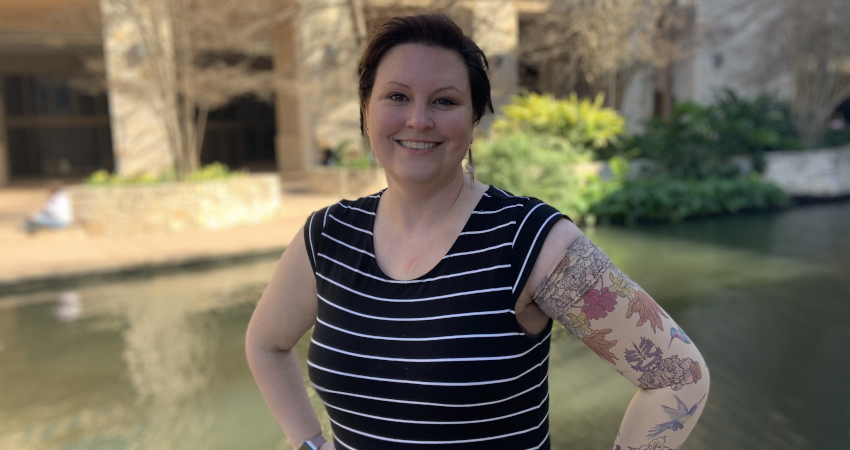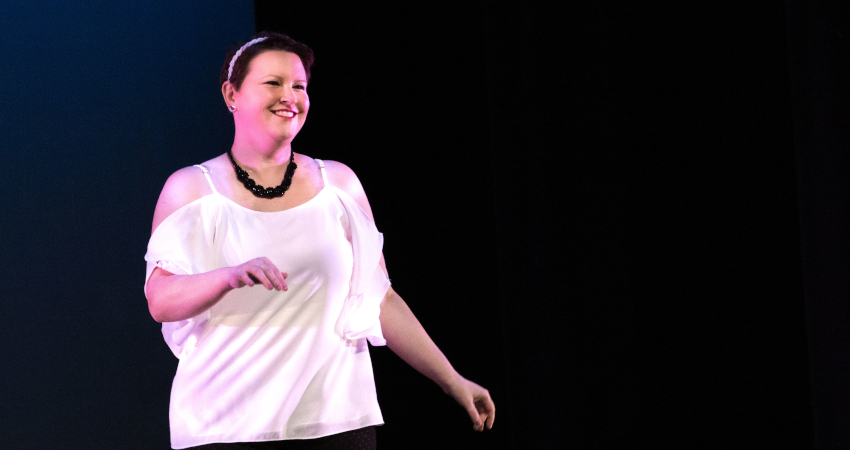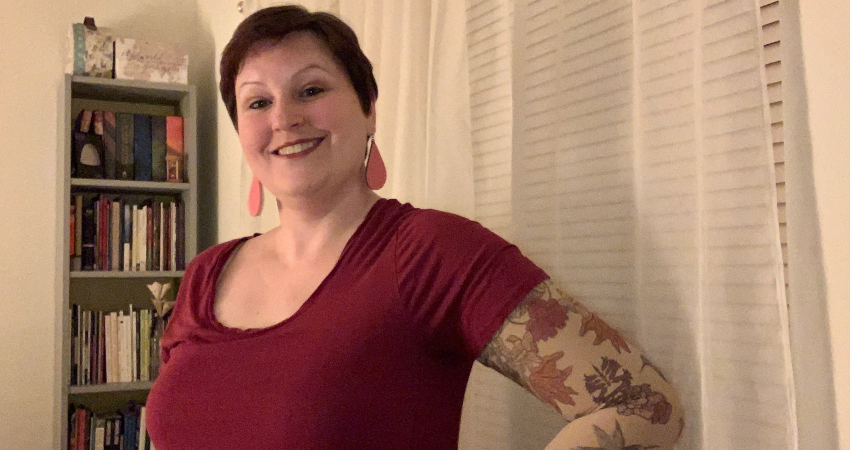Living with lymphedema: Katie Budris
- 04/07/20

After testing positive for breast cancer, Katie Budris learned the disease was also found in one of her lymph nodes. Her surgeon suggested that having chemotherapy before lumpectomy might reduce how many nodes would need to be taken out.
Having fewer nodes removed, the surgeon said, could lessen her risk of developing lymphedema, a treatment side effect that produces swelling and pain.
“That was about all that anybody said about the condition beforehand,” says Katie, who had stage II breast cancer. She read more about lymphedema online and hoped that the chemo-first plan would help her avoid the condition.
Katie’s surgery was in May 2019. About a month later, her physical therapist took a baseline measurement of her arm size and volume, before Katie started radiation treatment. Radiation also increases lymphedema risk. Measurements taken at intervals can detect swelling.
The baseline evaluation showed “a little bit of very mild lymphedema” in her left upper arm (her surgical side), she says. It was about 5 percent larger in volume than her non-surgical side.
Katie, who lives in Deptford, New Jersey, teaches writing at a university and performs with a professional tap dance company. Her physical therapist advised her to wear a special garment that can control swelling, called a compression sleeve, when she was physically active. She began using the sleeve, but the swelling still got worse.
Katie talked with LBBC contributing writer Robin Warshaw about what having lymphedema has meant for her. Her experiences offer insights to others who might develop this side effect of breast cancer treatment.

Robin: What happened when the lymphedema worsened?
Katie: My arm felt very heavy and it looked visibly swollen. It felt like it was more full. To the touch, I could tell that the tissue was hardened, especially in the forearm.
My arm swelled up pretty intensely. When I went back to my PT, she found that it was at 19 percent increased volume.
Robin: That was more than triple the volume measured early on. How did you treat it?
Katie: Right away, my PT ordered me short-stretch compression bandages [used for complete decongestive therapy, or CDT]. When they came in, I had to do 2 weeks of intensive bandage wrapping, wearing the bandages 24 hours a day, to try to reduce the volume in my arm.
The PT would rewrap the bandages every 2 days because they have to be changed. On the weekend, my husband had to do it. My PT took a video of herself doing the wrapping on me so my husband could follow at home.
It got me down to 8 percent from 19 percent and that made a big difference. I still have the bandages in case I have another flare-up.
Robin: Why do you think the increase happened?
 Katie: I had been wearing a compression sleeve for exercise and in rehearsals but not for performances. I underestimated the toll that multiple performances in one weekend would have and didn’t anticipate that the few minutes I was on stage would have such a big impact.
Katie: I had been wearing a compression sleeve for exercise and in rehearsals but not for performances. I underestimated the toll that multiple performances in one weekend would have and didn’t anticipate that the few minutes I was on stage would have such a big impact.
Robin: After bandage wrapping ended, what did you do to control lymphedema?
Katie: My PT told me to wear a sleeve all day. I also had to switch from wearing a gauntlet [fingerless glove worn with sleeve] on my hand to a glove with fingers until the swelling decreased.
She ordered me a custom-made sleeve to wear for activity or as much of the day as I can. I prefer the thinner sleeves that I had worn previously because they’re more comfortable. I wear the heavier custom one for dancing and any other exercise.
She also ordered me a night garment for sleeping. It’s like a giant oven mitt that covers my entire arm [up to armpit], so that overnight it doesn’t swell back up again. I put a light cotton liner on underneath to protect my skin. The mitt has padding and a layer over the top that provides light compression.
When I was doing bandage wrapping I couldn’t wear my wedding rings because my fingers were wrapped as well. Now that I’m wearing a gauntlet again, I wear my rings back on the left side. I have to be very aware if they start to feel tight as I take them off, because they could trigger lymphedema in my hand.
Robin: What do compression sleeves cost?
Katie: An “off the shelf” sleeve with a gauntlet or glove costs about $160 to $210. Most doctors recommend having at least two sets so you wear one while you wash the other. I have three sets and wish I had more. Not everyone can wear off-the-shelf sleeves, depending on their swelling and size.
I also have a custom-made sleeve to wear when exercising, for increased compression. That’s $400. My night garment is $450. Garments need to be replaced every 6 months to maintain compression.
Once a week, I wash the whole bunch in a mesh bag on a low cycle and dry on low. They don’t come with laundry instructions but in reading online I saw that hand-washing or hanging them to dry causes them to stretch out and lose compression.

Robin: Does your insurance cover any costs?
Katie: Yes, but not all insurance does. At first, mine covered 6 garments every 6 months, so I could get 3 sleeves and 3 gloves. My insurance changed and now only 90 percent is covered. I’ll have to spend $125 every 6 months to restock the minimum number of garments I need.
Medicare currently does not cover most lymphedema treatment, including sleeves, so many insurance companies don’t cover it. Advocates are trying to change that through the Lymphedema Treatment Act. This is a lifelong condition and compression is the only way to manage it. It blows my mind that for some people this isn’t covered.
My PT visits are covered but I need to ask my surgeon for a prescription for them. There also aren’t many lymphedema specialists in my area. It’s tough to get appointments that fit my schedule, especially at the last minute if I have a flare-up.
Robin: Has lymphedema been challenging to you emotionally as well as physically?
Katie: When it first swelled up, I was mostly angry. I think some of it was anger at myself for not wearing the sleeve during my dance performance. But I’ve had a lot of anger at the situation in general.
Through all of my cancer treatment, everything was temporary. It was easy to get through eight rounds of chemo, because I knew it was only eight rounds. Even losing my hair, knowing that it would grow back, that I had a wig, that it would be fine down the road. I was fortunate being a good candidate for lumpectomy. I could keep my breasts and recover from surgery. Radiation was temporary.
Everything had an endpoint. It’s been difficult to grasp the fact that this does not have an endpoint.
This was something that wasn’t caused by my cancer, it was caused by my cancer treatment. Which is angering and frustrating. Obviously, I needed the life-saving treatment. But as a result, now I have this lifelong condition. I have to be extra-cautious about over-exerting, not injuring my arm, and having this uncomfortable thing I have to wear all the time.
Robin: Is the lymphedema under control now?
Katie: I saw my PT a couple weeks ago and it was at 6 percent. She was satisfied with that for the time being. I’m supposed to continue managing it on my own and wearing the garments. I’ll see her again in 6 months to see if the swelling is consistent or if it has increased. Hopefully, it will stay consistent.
Now that I’ve come out on the other side of cancer, I have to figure out what this new life looks like with lymphedema. I’m still trying to figure out what I need for emotional support, whether I need to see a mental health therapist of some sort. I’ve been interested in trying more yoga and meditation for emotional support and also for healing my body, if I can find ways to do yoga that will not aggravate my lymphedema. I’m still working on that.
This article was supported by the Grant or Cooperative Agreement Number 1 U58 DP005403, funded by the Centers for Disease Control and Prevention. Its contents are solely the responsibility of the authors and do not necessarily represent the official views of the Centers for Disease Control and Prevention or the Department of Health and Human Services.
Stay connected
Sign up to receive emotional support, medical insight, personal stories, and more, delivered to your inbox weekly.


